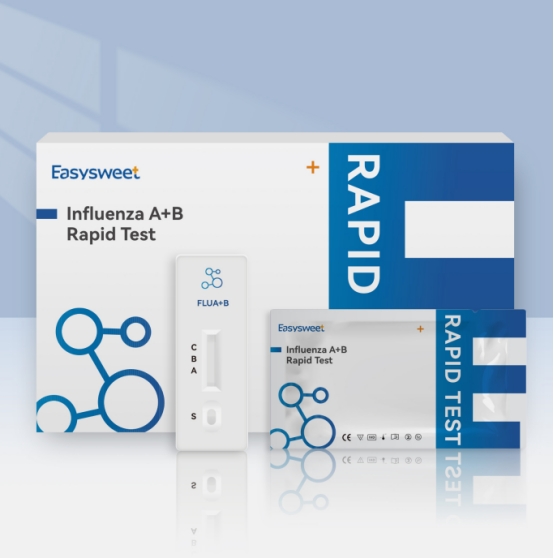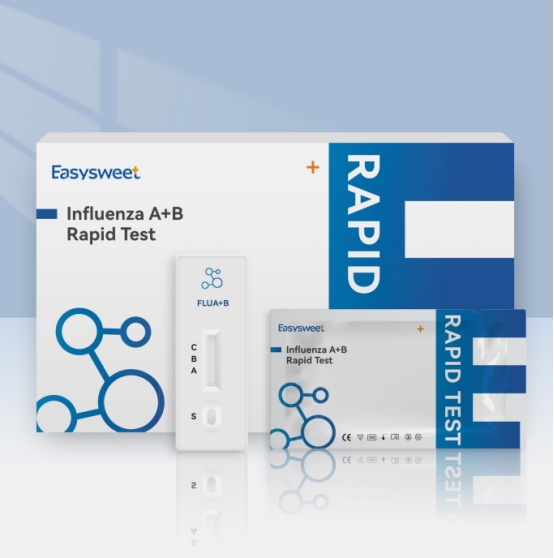The Easysweet Influenza A+B Rapid Test is an immunoassay that identifies the presence of influenza A and B virus nucleoprotein antigens in respiratory samples and displays the results in a qualitative manner (positive vs. negative). The reference standard for laboratory confirmation of influenza virus infection in respiratory samples is reverse transcription polymerase chain reaction (RT-PCR) or viral culture. RIDTs can produce results in a clinically relevant time frame, i.e. less than approximately 15 minutes.

The RIDT does not include rapid molecular tests that are more sensitive than the RIDT for detecting influenza virus in respiratory specimens.
Advantages and disadvantages of Easysweet Influenza A+B Rapid Test
Pros: Fast results in about 15 minutes, easy to use
Some RIDTs have been cleared for office/bedside use. RIDTs that have waived CLIA can be used in settings that include point-of-care.
Cons: Suboptimal test sensitivity, false negative results are common, especially if flu activity is high
RIDT is less sensitive for detection of influenza B virus antigen than for detection of influenza A virus antigen.
While specificity is high, false positive results can also occur, especially when influenza activity is low.
Some RIDTs distinguish between influenza A or B viruses, while others do not. RIDTs that provide results for influenza virus types (eg, influenza A or B) do not provide information on influenza A subtypes [eg, A(H1N1)pdm09 vs. A(H3N2)] or specific strains (eg, , similarity to the vaccine strain). RIDT cannot distinguish between seasonal influenza A virus infection and novel influenza A virus infection (due to infection with avian influenza virus or mutated influenza A virus).
Using the Easysweet Influenza A+B Rapid Test in Clinical Decision Making
RIDTs can be used to assist patients in clinical settings with diagnostic and treatment decisions, such as whether to prescribe antiviral drugs. However, because of limited sensitivity, negative results from RIDTs do not exclude influenza virus infection in patients with influenza symptoms and signs. Therefore, antiviral treatment should not be discontinued in patients with suspected influenza if clinically indicated, even if they have a negative RIDT test result, and further testing of respiratory samples by molecular testing for influenza may be warranted. More information on antiviral medicines and advice on their use.
Not all patients with influenza symptoms and signs require testing to make antiviral treatment decisions. Once influenza activity has been documented in a community or geographic area, a clinical diagnosis of influenza can be made in outpatients with signs and symptoms consistent with suspected influenza, especially during periods of peak community influenza activity.
Using RIDT for public health purposes to detect influenza outbreaks
RIDT can be used to identify influenza virus infection as the cause of respiratory outbreaks in any setting, especially in institutions (i.e., nursing homes, chronic care facilities, and hospitals), cruise ships, summer camps, schools, etc. Positive RIDT results from one or more suspected influenza patients can support decisions to implement timely infection prevention and control measures for influenza outbreaks. However, because of the limited sensitivity of these tests, a negative RIDT result does not exclude influenza virus infection as the cause of respiratory outbreaks. If influenza virus is the cause of the outbreak, testing respiratory samples from several patients with suspected influenza will increase the likelihood of detecting influenza virus infection, and if the cause of the outbreak has not been determined and influenza is suspected, molecular testing such as RT-PCR is recommended . Public health authorities should be notified immediately of any suspected institutional outbreak, and respiratory specimens (whether RIDT positive or negative) should be collected from patients and sent to public health laboratories for more accurate influenza testing by molecular assays and viral culture.
Many factors can affect the accuracy of the Easysweet Influenza A+B Rapid Test, including:
Clinical signs and symptoms consistent with influenza
Having clinical signs and symptoms consistent with influenza increases the pretest probability of influenza virus infection, thereby increasing the reliability of a positive RIDT result.
Prevalence of influenza activity in the population tested
Influenza activity varies seasonally, which directly affects the predicted value of RIDT, as well as seasonal influenza prevention strategies in healthcare settings.
Time from onset of illness to collection of respiratory samples for testing
If a patient has influenza, test samples collected within 3-4 days of illness onset (when influenza virus shedding is highest) are more likely to yield positive RIDT results.
Sensitivity of RIDTs
Proportion of positive RIDT results among all positive "gold standard test" results (RT-PCR or viral culture)
Fixed nature of the test; RIDTs are typically low to moderate (50-70%)
RIDT with low sensitivity can produce negative results (false negatives) in some patients with influenza
Specificity of RIDT
Proportion of negative RIDT results for all negative "gold standard test" results (RT-PCR or viral culture)
Fixed nature of the test; RIDT is usually very high (90-95%)
RIDT with low specificity will produce positive results in some patients who do not have influenza (false positive)
Interpretation of Influenza Rapid Diagnostic Test Results
Correct interpretation of Easysweet Influenza A+B Rapid Test results is important for clinical management of patients and evaluation of suspected influenza outbreaks. Many factors can affect the results of the Easysweet Influenza A+B Rapid Test. The accuracy of Easysweet Influenza A+B Rapid Test depends to a large extent on the conditions under which they are used. Knowing some basic considerations can minimize misleading by false positive or false negative results.
positive result
A positive result means that the RIDT detected influenza virus antigens, but does not necessarily mean that live influenza virus is present or that the patient is infectious.
The Easysweet Influenza A+B Rapid Test has the highest positive predictive value (proportion of patients with a positive result having influenza) when there is high influenza activity in the population being tested (e.g. a community).
A negative result means that the RIDT did not detect any influenza virus antigens.
The negative predictive value (proportion of patients with negative results who do not have influenza) of RIDT is highest when influenza activity is low in the population being tested (e.g., a community).
Negative results are likely to be true negatives if respiratory samples are collected close to (within 4 days) the onset of illness during periods of low influenza activity (e.g. summer) in the population being tested (e.g. community).
The negative predictive value (proportion of patients with negative results who do not have influenza) of RIDT is lowest when influenza activity is high in the population being tested (e.g., a community).
If there is any infringement, please contact us.


